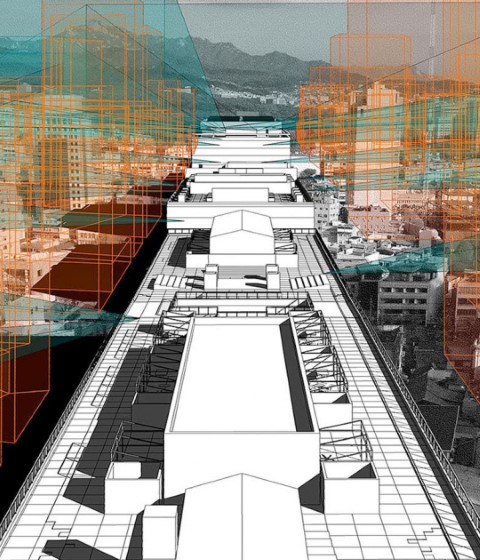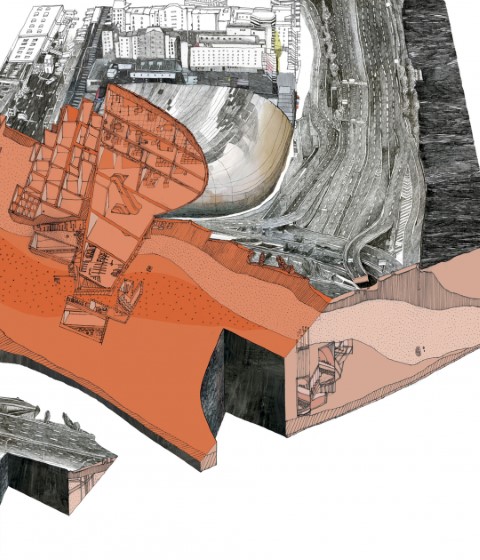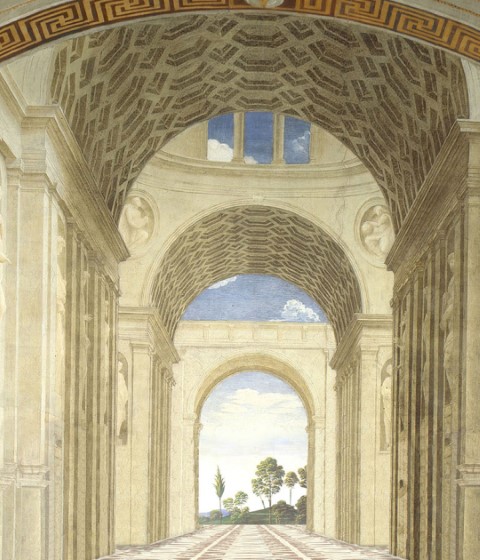The exhibition of the Korea Pavilion, "Specters of the state avant-garde", responds to the theme "Freespace" of the 2018 Venice Biennale shedding light on a hidden narrative of Korea's paradoxical quest for a utopian society through government policy oppressive
The Korean Pavilion at the 16th International Architecture Exhibition – La Biennale di Venezia will present Spectres of the State Avant-garde, an archive of four key state projects developed by the government-established Korea Engineering Consultants Corp. (KECC) during Korea’s industrialization and modernization of the 1960s; and seven contemporary interpretations of those projects by young Korean artists and architects. Together, the archive and its reimagining form an atmospheric installation addressing the KECC’s legacy and its influence on modern day Korean society.
KECC enjoyed an unparalleled dominance over Korea’s architecture and construction industry, and the breadth of its activities reached beyond civil engineering and infrastructural projects to include urban master plans and expo pavilions. The exhibition presents an archive of four projects by KECC from the late 1960s, all of which served as nation-building propaganda: The Expo Pavilion for Osaka Expo 1970 was a venue for showcasing Korea as a nation-state on the world stage; the utopian master plan for Yeouido symbolized the brilliant future promised by the economic development plans; the Sewoon Arcades heralded the wave of urban renewal projects, and the Guro Industrial Exposition signaled the beginning of a new era of affluence. The first two projects were symbolic gestures for announcing the trajectory of the new nation-state, whereas the other two projects were evidence for the imminent realization of economic prosperity.
Three special commissions include a documentary film Fantastic City by artist Hyun Suk Seo, an installation, Reference Points, by photographer Kyeongtae Kim, and a new fiction work, Light from Anywhere, by writer Jidon Jung. Fantastic City examines the role and vision of KECC through the testimonies of people whose lives were affected by the consultancy. Reference Points is an installation of new “architectural images” representing KECC’s four projects—Sewoon Sannga, Yeouido, Expo ’70, and the Guro Trade Fair. The warped, merged images are joined together according to their fragmented shapes, stitching the disjointed history into a compositewhole. Light from Anywhere is based on the story of Taesoon Jung, who worked as a guide for the Korean Pavilion at the Expo ’70 in Osaka.
Four architectural projects re-imagine KECC’s developments to inform the future of Korean architecture. City of Radical Shift by architect Sungwoo Kim (N.E.E.D. Architecture) projects into the future of the area surrounding the KECC's Sewoon Arcades, creating an urban plan that incorporates past, present and future buildings with a view to the social and cultural perspective of residents in the city. Dream Cells by Jinhong Jeon and Yunhee Choi of BARE proposes a visionary urban model based on the understanding of architecture as a socio-economic process of dream production. Autopsy of the Future by architect Choon Choi is an installation that collects forgotten stories and utopian dreams for Yeouido, as a collective social and aesthetic experiment. It is accompanied by a graphic novel in the catalogue exploring the layers of history on which the city is built. Building States by Hyun Seok Kang and Gunho Kim of SGHS is an installation inspired by the 1970 Osaka pavilion. Balancing the propaganda of the state with the visionary architecture of the creatives involved, SGHS present an installation that occupies a liminal space between built and imagined structures – transforming the exterior environment of the Korean Pavilion into a space for reflection and reimagining the autocratic architecture of the past.
The Korean Pavilion have also published Spectres of the State Avant-garde, a collection of academic essays and archival documents that explore the complex relationship between modern architecture and the state. Through the juxtaposition of the contradictory terms “state” and “avant-garde,” the book highlights the schism between political power and artistic imagination and the inherent contradiction between political system and utopian ideals. As the first critical compilation of the projects by the KECC, the book provides an archival foundation for further studies on the historical legacy of the developmental state and its implications for the future of Korea’s civic space.
Edited by Junghyun Park, Sangho Kim, Jane Misun Shim, and Seongtae Park, Spectres of the State Avant-garde features an extensive list of archival photographs to complement the essays by four co-curators of the exhibition, in addition to contributions by seven historians—Nanhyoung Kang, Hyonkyoung Kim, Taehun Lim, Hyunjung Cho, ChunghoonShin ,HeonghyeKim, andChangmoAhn. SpectresoftheStateAvant-gardealsoincludestwo special features as books within a book: the Bamseom—Seeds of Change is an illustrated story about an alternate utopia for Bamseom, an island that was destroyed for construction of Yeouido, and the Light From Anywhere by writer Jidon Jung, an fiction based on a true story about a volunteer guide at the Korean Pavilion at the Expo ’70 in Osaka.
The Korean Pavilion at the 16th International Architecture Exhibition – La Biennale di Venezia will present Spectres of the State Avant-garde, an archive of four key state projects developed by the government-established Korea Engineering Consultants Corp. (KECC) during Korea’s industrialization and modernization of the 1960s; and seven contemporary interpretations of those projects by young Korean artists and architects. Together, the archive and its reimagining form an atmospheric installation addressing the KECC’s legacy and its influence on modern day Korean society.
KECC enjoyed an unparalleled dominance over Korea’s architecture and construction industry, and the breadth of its activities reached beyond civil engineering and infrastructural projects to include urban master plans and expo pavilions. The exhibition presents an archive of four projects by KECC from the late 1960s, all of which served as nation-building propaganda: The Expo Pavilion for Osaka Expo 1970 was a venue for showcasing Korea as a nation-state on the world stage; the utopian master plan for Yeouido symbolized the brilliant future promised by the economic development plans; the Sewoon Arcades heralded the wave of urban renewal projects, and the Guro Industrial Exposition signaled the beginning of a new era of affluence. The first two projects were symbolic gestures for announcing the trajectory of the new nation-state, whereas the other two projects were evidence for the imminent realization of economic prosperity.
Three special commissions include a documentary film Fantastic City by artist Hyun Suk Seo, an installation, Reference Points, by photographer Kyeongtae Kim, and a new fiction work, Light from Anywhere, by writer Jidon Jung. Fantastic City examines the role and vision of KECC through the testimonies of people whose lives were affected by the consultancy. Reference Points is an installation of new “architectural images” representing KECC’s four projects—Sewoon Sannga, Yeouido, Expo ’70, and the Guro Trade Fair. The warped, merged images are joined together according to their fragmented shapes, stitching the disjointed history into a compositewhole. Light from Anywhere is based on the story of Taesoon Jung, who worked as a guide for the Korean Pavilion at the Expo ’70 in Osaka.
Four architectural projects re-imagine KECC’s developments to inform the future of Korean architecture. City of Radical Shift by architect Sungwoo Kim (N.E.E.D. Architecture) projects into the future of the area surrounding the KECC's Sewoon Arcades, creating an urban plan that incorporates past, present and future buildings with a view to the social and cultural perspective of residents in the city. Dream Cells by Jinhong Jeon and Yunhee Choi of BARE proposes a visionary urban model based on the understanding of architecture as a socio-economic process of dream production. Autopsy of the Future by architect Choon Choi is an installation that collects forgotten stories and utopian dreams for Yeouido, as a collective social and aesthetic experiment. It is accompanied by a graphic novel in the catalogue exploring the layers of history on which the city is built. Building States by Hyun Seok Kang and Gunho Kim of SGHS is an installation inspired by the 1970 Osaka pavilion. Balancing the propaganda of the state with the visionary architecture of the creatives involved, SGHS present an installation that occupies a liminal space between built and imagined structures – transforming the exterior environment of the Korean Pavilion into a space for reflection and reimagining the autocratic architecture of the past.
The Korean Pavilion have also published Spectres of the State Avant-garde, a collection of academic essays and archival documents that explore the complex relationship between modern architecture and the state. Through the juxtaposition of the contradictory terms “state” and “avant-garde,” the book highlights the schism between political power and artistic imagination and the inherent contradiction between political system and utopian ideals. As the first critical compilation of the projects by the KECC, the book provides an archival foundation for further studies on the historical legacy of the developmental state and its implications for the future of Korea’s civic space.
Edited by Junghyun Park, Sangho Kim, Jane Misun Shim, and Seongtae Park, Spectres of the State Avant-garde features an extensive list of archival photographs to complement the essays by four co-curators of the exhibition, in addition to contributions by seven historians—Nanhyoung Kang, Hyonkyoung Kim, Taehun Lim, Hyunjung Cho, ChunghoonShin ,HeonghyeKim, andChangmoAhn. SpectresoftheStateAvant-gardealsoincludestwo special features as books within a book: the Bamseom—Seeds of Change is an illustrated story about an alternate utopia for Bamseom, an island that was destroyed for construction of Yeouido, and the Light From Anywhere by writer Jidon Jung, an fiction based on a true story about a volunteer guide at the Korean Pavilion at the Expo ’70 in Osaka.





































